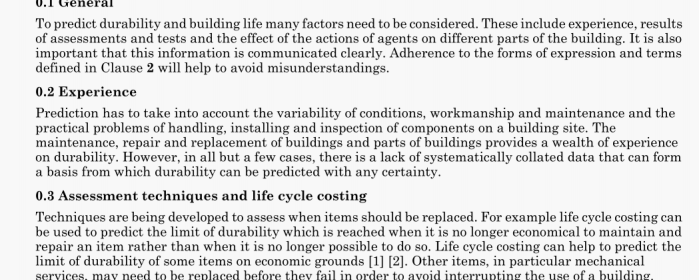Guide to durability of buildings and building elements, products and components

BS 7543:2003 pdf free.Guide to durability of buildings and building elements, products and components.
A badly stated requirement for design life, can lead to misunderstanding at a later date. When a period for required service life is given the following information is essential:
a) time (or a time measure such as running time or cycles of use) against which durability is to be assessed:
b) conditions in which the item will have to perform (i.e. environmental conditions and levels of maintenance and usage);
c) performance point at which functions become unsatisfactory (for example the light transmission through a glass reinforced plastics (GRP) rooflight decreases over the period of use. A decision has to be made on when to change the rooflight for a new one that will give a greater light transmission).
The required service life for a building should be qualified by additional information on conditions of use and maintenance levels. Table I lists three levels of maintenance based on the types of inspection described in 4.2.3 of BS 8210:1986.
When seeking predicted service life statements from manufacturers the required service life for parts of buildings should also be qualified by information of the following two types.
a) Information on exposure. This is particularly important where the required service life is part of a
performance specification presented to a manufacturer supplying external components for use in a
building that is not known to him.
b) Details of adjacent materials and fixings. The movement of adjacent components and the chemical compatibility of materials is often critical to the durability of an assembly. These details are particularly important when the required life is given to a manufacturer of components in a performance specification. General statements and schematic details may not he enough to identify risks. It is essential that the allowances made for thermal and moisture movement and for isolating incompatible materials are fully described.
Very durable, long lasting construction is usually more expensive and may restrict the design to a limited range of materials. Consequently a long required service life is likely to increase the cost of the project and can limit the design solutions that meet the brief.
Funding of building construction often implies a required service life at least as long as the period of the loan used to finance the building.
This British Standard gives guidance on durability, required and predicted service life and design life of buildings and their components and/or parts. It applies primarily to new buildings and their components and/or parts rather than to alterations and repairs. It also gives guidance on presenting information on the service and design life of buildings and their components and/or parts when a detailed brief is being developed.
This British Standard applies to civil engineering projects involving buildings, but only partially to other civil engineering projects such as roads, bridges and dams.
This British Standard does not deal with many aspects of obsolescence. i.e. when buildings or parts of buildings are replaced or altered either to suit different needs and changing conditions including change of use, mandatory requirements or when new products offer better performance without a corresponding increase in cost. It should also be borne in mind that a decision to replace or alter obsolete buildings or their parts may be influenced by a reassessment of their predicted service lives.
NOTE I The titles of the publications referred to in this standard are listed on the inside back cover.
NOTE 2 The numbers in square brackets in the text of this standard refer to the numbered references in Annex C.
For the purposes of this British Standard the definitions in BS ISO 15686 apply together with those given in BS 6100.BS 7543 pdf download.Guide to durability of buildings and building elements, products and components